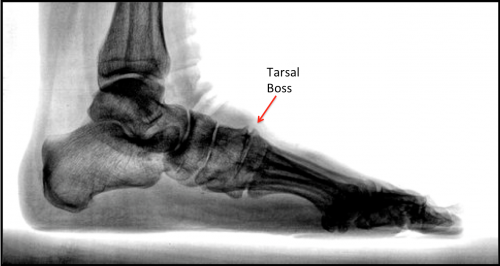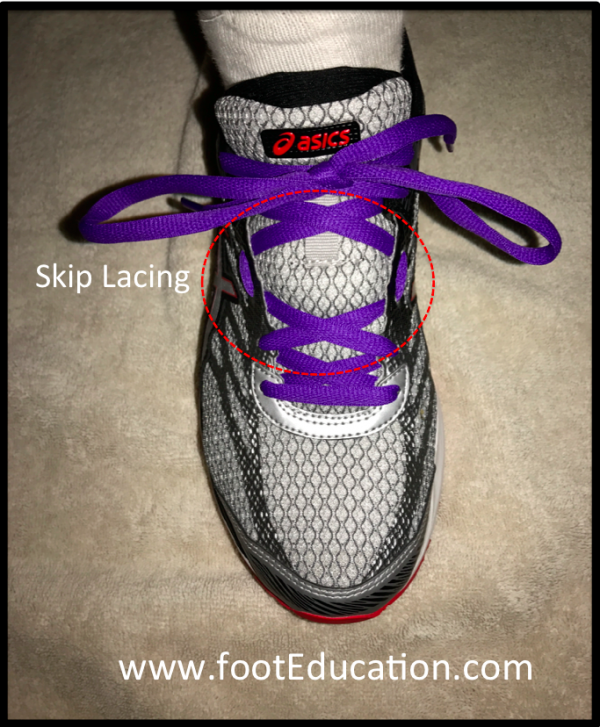Tarsal Boss (Dorsal Exostosis)
Summary
A tarsal boss is characterized by a prominence on the top of the midfoot. This prominence is also known as a dorsal exostosis and may become painful. Symptoms are often aggravated by constrictive footwear. The underlying problem is a prominent bone spur. This can occur naturally, or in response to arthritis in one or more of the midfoot joints. Treatment of a tarsal boss is usually non-operative, aimed at avoiding direct pressure over the prominent bone. Taking care to ensure that the tongue of the shoe is not tied tightly and that there is an associated soft padding over the bony prominence can greatly improve symptoms. In addition, stiff soled shoes can and skip lacing be helpful with respect to symptoms. Occasionally, surgical removal of the bone spur or even fusion of the underlying arthritic bone joint may be necessary.
Clinical Presentation
A lump on the top of the foot is the main symptom of a tarsal boss. In many individuals this lump can become painful at times. The lump is usually located over the mid part of the foot. It may create pain with constrictive footwear. It may also be associated with an aching pain in the mid foot, as some midfoot bony prominences are due to the presence of bone spurs from midfoot arthritis.
Physical Examination
An examination will demonstrate a lump on the top (dorsal aspect) of the midfoot. This lump is often hard from the underlying bone. This differentiates a tarsal boss from a ganglion cyst, which is a fluid-filled sac that is usually softer and mobile.
Imaging
Plain x-rays of the foot will usually reveal a bone spur in the top part of the midfoot. (Figure 1)
Figure 1: Foot X-Ray showing Tarsal Boss (midfoot Bone Spur)

The tarsal boss, or bone spur, most frequently occurs at the first, second, or third tarsal-metatarsal joints, and is often an indication of wear and tear in these joints, (midfoot arthritis). Essentially, the bone spur creates the prominence, which leads to the localized discomfort from the pressure caused by a constrictive shoe.
Treatment of Tarsal Boss
Non-operative Treatment
Most patients witha. symptomatic tarsal boss can be treated successfully without surgery. Creating a soft area in the shoe, and not tying shoes quite as tightly over this area will often lead to resolution of these symptoms. However, the prominence on the top of the foot will usually remain. In addition, shoes with an associated stiff sole can be helpful as this will put less force through the mid part of the foot. Another technique, called “skip lacing” (Figure 2), reduces pressure by skipping the crossed part of the laces that would normally cross directly over the prominence.
Figure 2: Skip Lacing

Surgical Treatment
Occasionally the prominence of the bone spur or of the associated pain from the underlying midfoot arthritis of the tarsal-metatarsal joints will necessitate surgical intervention. In this instance, there are two surgical procedures that can be performed:
- Removal of the prominent dorsal bone spur. A fairly straight forward operation can be performed to identify the bone spur and remove it. This is associated with a relatively quick recovery time. However, usually the underlying reason why the bone spur occurred (wear and tear in the tarsal-metatarsal joint) is not addressed. Therefore, there is a higher likelihood that the bone spur will reoccur over time.
- Fusion of the midfoot joints. If the bone spur is a product of significant midfoot arthritis, which is also symptomatic, a fusion of this joint- or joints, (midfoot arthrodesis) may be beneficial. This involves preparing the joint, fixating it with screws or a plate, and keeping off the foot for a 6-8 week period, until adequate fusion has occurred. This type of surgery is much more involved than a simple removal of the bone spur, and may be associated with the typical complications that can occur with fusion surgery.
Edited by Stephen Pinney, MD November 10th, 2025. Previously edited by Judith Smith MD